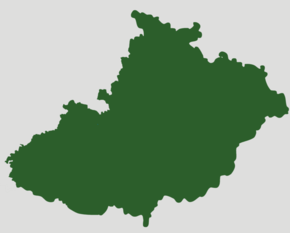Moravia-Silesia
This article needs more links to other articles to help integrate it into the encyclopedia. (September 2022) |
This article contains information pertaining to a simulationist micronation, micronationalist or other element of micronational society or culture. |
Moravian-Silesian Republic | |
|---|---|
| Motto: Genius Loci | |
| Anthem: Moravo, Moravo | |
 | |
| Capital | Olomouc |
| Largest city | Brno |
| Official languages | moravian |
| Demonym(s) | Moravian-Silesian |
| Government | Republic |
| Legislature | Assembly of the Moravian-Silesian Republic |
| Population | |
• Census | 4.000.000 |
| Currency | Moravian-Silesian Kirat |
Website moravskoslezskar.cz | |
Moravia-Silesia (Moravskoslezsko, long form Moravian-Silesian Republic) is an inland micronation in Central Europe, bordering Poland, Slovakia, Austria and the Czech Republic and has a disputed territory with Radoslavia. The capital is Olomouc, the largest city is Brno, other large cities are Ostrava, Zlín, Havířov and Opava.
On May 1, 2012, the State of Moravia was established as the first Moravian micronation. Between 2014-2017 it was a member of the federations. The Moravian Republic was established in 2017 and was renamed the Moravian-Silesian Republic in 2018.
Moravia-Silesia has been a member of the Society of Micronations since its inception (predecessors since 2016). Moravia-Silesia is a parliamentary democracy with democratic institutions. Of the surrounding micronations, Moravia-Silesia has strong ties especially with Mekniy and Lurk.
History
In May 2011, the first Moravian micronation, the State of Moravia, was established near the town of Šumperk. Later, it extended its scope to first the entire territory of Moravia and later to Silesia. In the summer of 2012, Moravia, as an independent micronation, disappeared and first became part of the renewed USSR and then Czechoslovakia.
In the summer of 2017, national pressure intensified in Czechoslovakia, after which the federation was abolished. While the Czech Socialist Republic and the Slovak Socialist Republic disappeared, the Moravian Socialist Republic transformed into the Moravian Republic.
The new republic has long struggled with problems of national and linguistic identity, administrative organization and the willingness of citizens to participate in the political life of the micronation. Therefore, in October 2018, a decision was made to transform it into the Moravian-Silesian Republic, and on October 28, 2018, the Constitution was adopted.
Politics
Political System
According to the 2019 constitution, Moravia-Silesia is a parliamentary democratic republic. The head of state is the president, who is elected for a five-year term. The body of legislative power is the Assembly. The executive power of the country is exercised by the Government of the Moravian-Silesian Republic headed by the Prime Minister.
The government consists of a prime minister, deputy prime ministers and ministers. The government appointed by the president must submit its political program to the Assembly within 30 days of his appointment and ask for the Assembly's confidence. In addition, it may at any time ask the Assembly to express its confidence and, in principle, to link each vote to a question of confidence. The Assembly may refuse to trust the Government or any of its members. This requires an absolute majority of all deputies, but a vote of confidence in the government is taken by a simple majority. The consequence of the Assembly's failure to express confidence in the government is the removal of the government by the president.
The Moravian-Silesian Parliament is the Assembly of the Moravian-Silesian Republic, which acts as a unicameral parliament with a total of 51 members and is elected every four years.
Territorial division
From 1 January 2022, Moravia-Silesia is divided into 47 counties, which are further divided into municipalities. Counties and municipalities are self-governing territorial units, which are administered by county and local (city) national committees.

